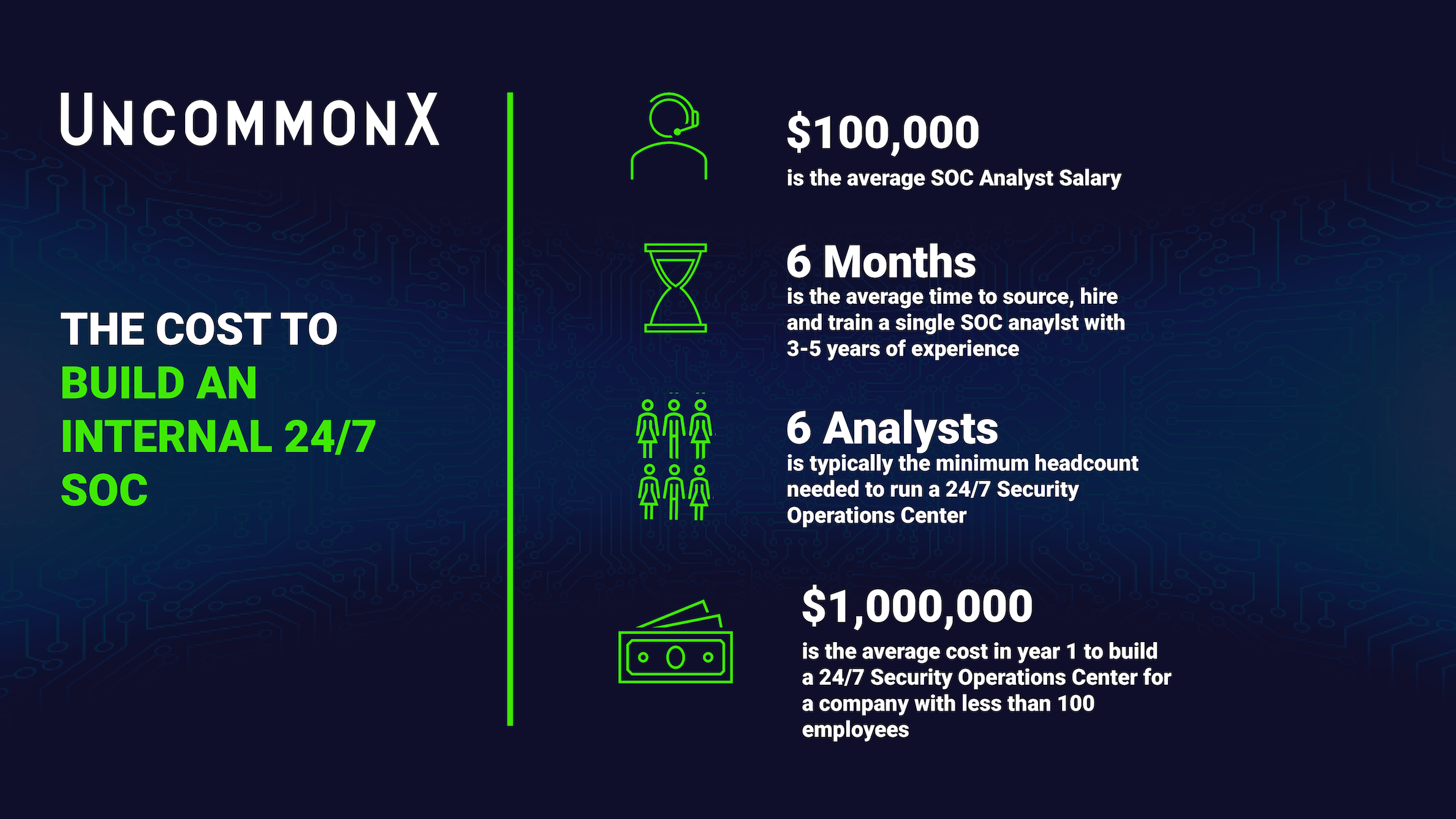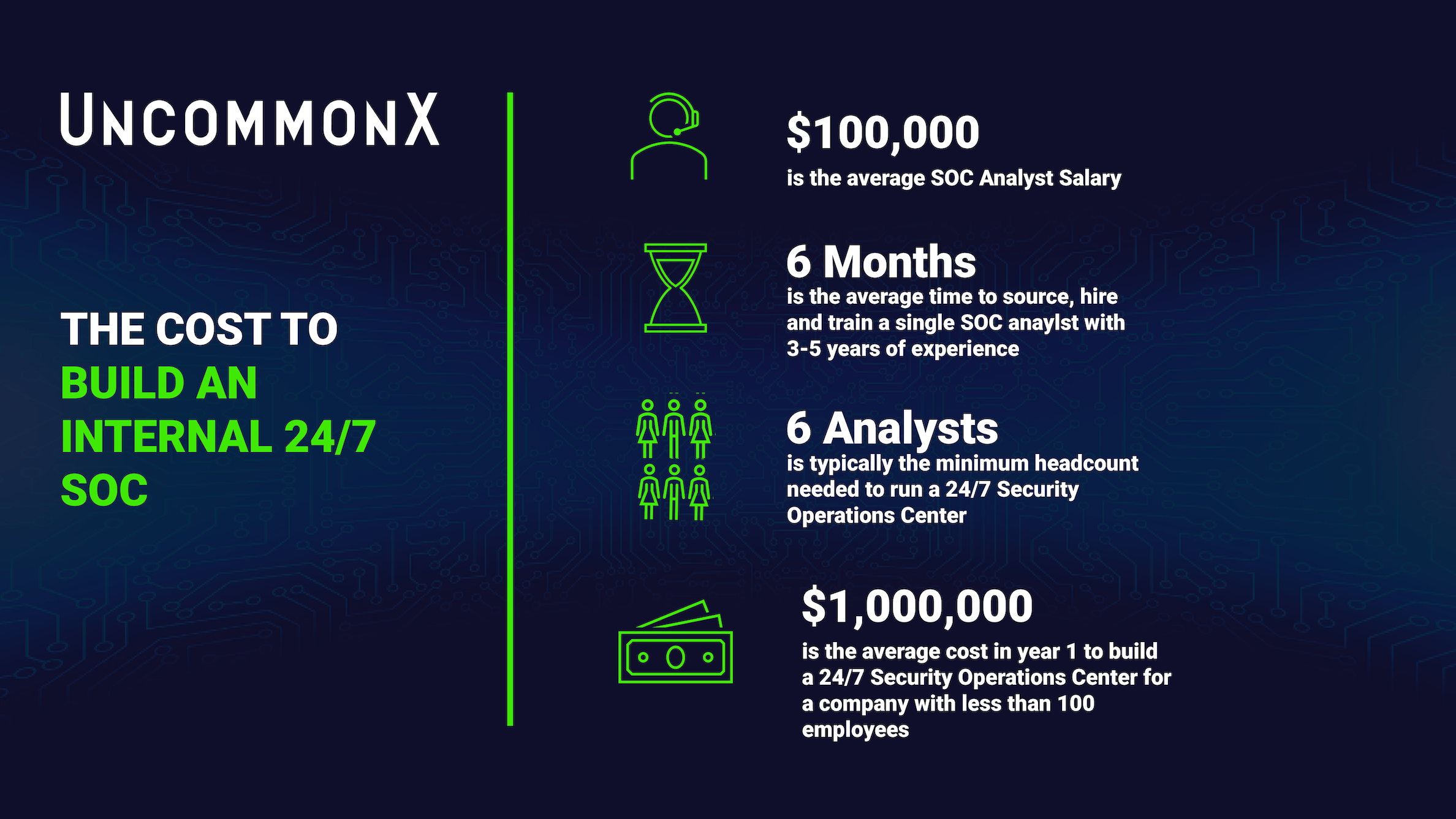1 min read
To Build a SOC vs. Buy MDR
Acronyms to know: SOC: Security Operations Center MDR: Managed Detection and Response Millions of dollars are wasted each year when a company does...
Experiencing an active breach? Call us immediately at 1-866-405-9156 UncommonX has experienced ZERO reportable breaches.
4 min read
 SOC Team of Security Experts
:
Dec 5, 2022 2:45:18 PM
SOC Team of Security Experts
:
Dec 5, 2022 2:45:18 PM

Millions of dollars are wasted each year when a company does not have a security operations center (SOC) to protect and secure its data and the days of hoping that you can trust the internal IT department to keep you safe are gone. Within the State, Local and Education Government, Federal Government, Finance, Healthcare, Manufacturing, Retail and Insurance verticals the number of attacks are growing exponentially, in addition to the level of sophistication of these attacks, making it imperative organizations have an iron clad 24/7 Security Operations Strategy in place to mitigate risk.
According to Gardner attacks on organizations in critical infrastructure sectors have increased dramatically, from less than 10 in 2013 to almost 400 in 2020 — a 3,900% change. Whether to stop a cyber criminal seeking a large sum of ransomware to stop an attack, or to prevent confidential data being leaked, a SOC is your most important line of defense.
Components to consider when budgeting for an internal 24/7 SOC:
The three main components to factor in when budgeting to build a 24/7 SOC are the number of employees at your company, the number of assets or endpoints on your network and the level of SOC maturity you would like to reach at the end state.
The basic logic for employees with under 150 employees:

If you assume the average security analyst costs $100,000 a year and need 2 analysts working to cover (3) full eight hour shifts, that is a minimum of $600,000 a year just to cover the analysts salaries. Not too mention even within organizations who already have a security operations center and strategy in place, it takes on average 6 months to source, hire and train an analyst to get up to speed. When you factor in cost of software, hardware, training resources so the analysts can effectively do their job, it's fair to assume that an organization with 150 employees will spend well over $1 million dollars a year.
Since prehistoric times, humankind has developed tools to make their lives easier, more productive, and even safer. Yet those tools didn’t operate on their own. They needed people to weld them and use them in order to get the most out of them. Today, it’s the same. Only, these days, a vast number of tools are digital, and they need human oversight to implement and manage them now more than ever. This is especially true for cybersecurity.
For decades, the number and level of attacks, breaches, and potential dangers to vital data have escalated to the point where organizations in every industry are taking measures to ensure their assets and technical infrastructures are safeguarded. These threats are also becoming much more sophisticated almost every day. Yet too many companies are relying on security tools alone to protect them.
While artificial intelligence (AI) and machine learning have advanced dramatically the past few years, they still aren’t at a point where they can fully protect against the building storm of cyber threats. Effective security is much more than just plugging in some off-the-shelf device and then sitting back hoping for the best. In fact, that type of complacency can lead to disaster.
Here are a few reasons why.
Cyber criminals breach organizations by taking advantage of vulnerabilities within your environment. They’re like water: they pour over every inch of your network until they find an opening they can seep through. Then they flood your system, causing potentially irreparable damage.
But no matter how many devices you install, there’s a chance you may not cover every possible entry point. You also risk vulnerabilities if you install the wrong tools. All it takes is one gap or blind spot to expose you to attacks.
You may have devices covering every possible opening, but they aren’t omnipotent. Even the latest technology can’t see everything. That means there’s a chance some malware program could slip past.
Cyber threats continue to evolve every year and they’re getting more and more difficult to fight. One reason is cyber criminals are constantly creating nastier ways of crippling digital devices and entire networks. They’re experts at figuring out how to bypass most security tools sooner or later. Once they do, your tools are virtually useless.
Some software and devices are released by manufacturers unintentionally with built-in vulnerabilities or defects that can be exploited. Other tech will just wear out over time and stop working. Once those weaknesses are discovered, the information is shared amongst criminals, and it may not be long before they pierce your defenses.
Most tools require human involvement to ensure they’re being applied correctly, used effectively, and replaced immediately if they fail. Technology can relay data and send alerts, yet they can’t fully defend against attacks, especially from advanced threats sent by shrewd attackers.
Truly effective security is an integrated mix of end-to-end workflow and processes, the right technology for each job, and continuous management by dedicated, trained, and specialized security professionals. A team that can also proactively protect against security threats by developing and implementing security strategies and processes, and then adjusting as needed.
These professionals are also better able to do something technology can’t do alone: determine the validity and true priority of every security threat and vulnerability. Developers are working toward AI that can handle that responsibility, but for now, human insight is needed. They can align the priorities of these threats and determine which ones deserve immediate attention. Then they react quickly and respond accordingly.
Cyber attacks will continue to grow in size and severity. Experts and law enforcement agree that the best way to safeguard against them is for organizations to be proactive. Stop attacks before they happen by strengthening your security maturity levels. Having the right tools in place is critical, but technology alone should never be your only line of defense.
Security takes more than just installing the latest tools. Effective security combines the right technology, in-depth processes, and, most of fall, knowledgeable people. It should also integrate security goals with a company’s business objectives. That way organizations are protected without disrupting their ability to operate.
For more about protecting your organization, contact the UncommonX team to request a demo of our MDR platform and talk about your specific security needs.

1 min read
Acronyms to know: SOC: Security Operations Center MDR: Managed Detection and Response Millions of dollars are wasted each year when a company does...

Since prehistoric times, humankind has developed tools to make their lives easier, more productive, and even safer. Yet those tools didn’t operate on...

1 min read
Lack of cyber security knowledge and fatigue Human error is predicted to remain a major factor in cyber security threats for 2023. In 2022, research...